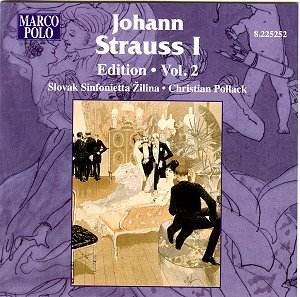This
could be quite a nice game to play on your friends. You announce
a Waltz by Strauss, put on the first track and after a couple
of tings from the bell, enter the solo violin and "Hey, youíve
got the wrong CD! This is La Campanella by Paganini". Right
and wrong; the first waltz is based on that famous theme, sounding
a little sedate in waltz-time.
I
reviewed Volume I in this series not long ago and queried
whether there was any particular reason for listening to six waltzes
rather than just one of them six times, and I also wondered whether,
when the second volume came out, one would be any better off getting
it as opposed to just playing the first one again; this because
the music, for all its charms, did not seem exactly memorable.
A contributor to the bulletin board has accused me of saying the
music was boring. I have searched the review in vain for such
a word and would like to know where he found it. The point I wanted
to make is that light music in general, even high quality light
music of this kind, tends to have a sort of sameness which arises
from the social function it performs. To say that it generally
isnít memorable doesnít detract from its effectiveness in the
context for which it is intended.
Now
the question is, does Volume 2 change anything? Up to a point,
yes. Iím still not going to say the music is really memorable.
Perhaps this is my personal problem, but after two hearings the
only tune I can actually remember is La Campanella. To tell the
truth, there are a few chirpy, waltzy themes running round my
head, but I couldnít say right now if they are from the disc or
whether they are tunes of the same kind Iíve been inventing myself
in the last hour or so. And before my correspondent takes umbrage,
Iíd like to know just how many tunes he can remember after
the first two hearings of this disc.
What
I do remember about the disc is the inventiveness of Straussís
orchestration. Surely nobody could claim great originality for
the themes of the Champagne-Walzer, yet the piquancy of the instrumentation
is a constant source of delight to the ear and ensures that attention
is held, even though at 8í01" this is the longest piece on
the disc. But this is only one example; considering how small
a band he had at his disposal, the gamut of colours he got out
of it in practically every piece here is amazing and in this respect
the music in this volume is a definite advance on the earlier
works in volume 1. What I miss are the long, soaring phrases of
which at least two of his sons were capable. In volume 3, perhaps?
The
conductor is again Christian Pollack, but he has a different orchestra.
I pointed out that he is a conductor in the Stolz tradition of
giving performances basically for dancing rather than concert
interpretations like Mehta or Muti. And since he also has a Stolz-like
ability to keep the rhythms crisp and fresh and to nudge knowingly
from one section to the next, as far as I am concerned this, for
a complete edition, is ideal. I felt that his previous orchestra,
the Camerata Cassovia, showed some pretty poor intonation. Here,
too, my correspondent objected, stating that in his opinion it
wasnít so. Unfortunately, intonation is based on mathematical
principles and mathematics is not an opinion. The present band
seems a little larger, and has been a little less closely recorded,
but if you listen to the exchanges starting around 2í30"
of track 9 you can hardly deny that there are discrepancies of
pitch between strings and wind, or that the clarinet tends to
play sharp right through the disc. This is not an opinion. Where
there is scope for disagreement is how far it matters to you.
Some people have a very low tolerance level and I should be neglecting
my duty if I didnít point out that they might have some problems
with these performances, though not to the same extent as in Volume
1. Evidently my correspondent has a high tolerance level; for
myself, I donít worry too much, when the spirit is so right, up
to about six pieces in a row. After that the intonation begins
to reduce my enjoyment.
Still,
this disc seems to me of rather wider interest than the first,
which was more for Strauss completists. But how many volumes will
there be, and will the next ones be better still?
Christopher
Howell
